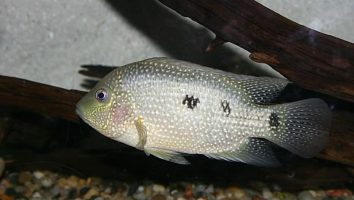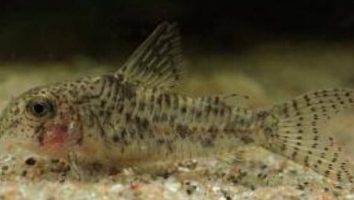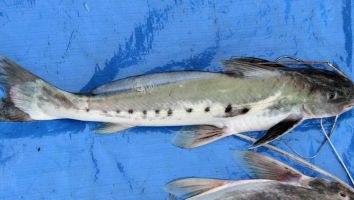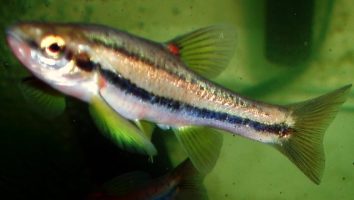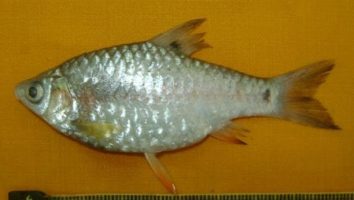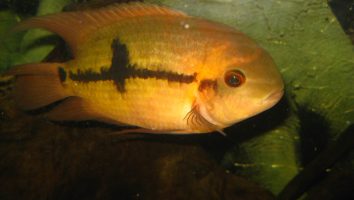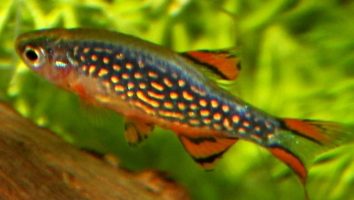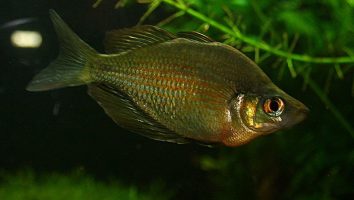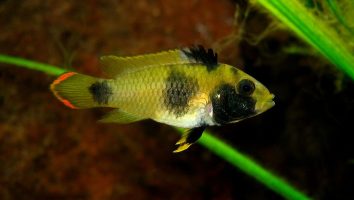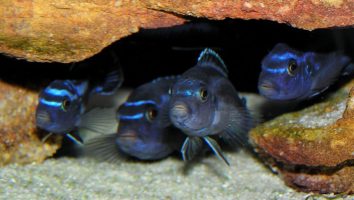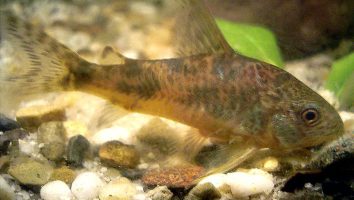Clown barbs are a beautiful freshwater fish that are easy to care for. They’re a peaceful species that does well in community tanks.
Clown barbs are a schooling fish, so we recommend getting at least 6 of them. They’re also an active swimmer, so make sure your tank is big enough to accommodate them.
In this guide, we’ll teach you everything you need to know about clown barb care. Tank size, diet, tank mates, and more. It’s all here!
Table of contents
Species overview
The clown barb (Puntius everetti) is a freshwater fish that’s native to the Malay Peninsula, Sumatra, and Borneo.
They inhabit slow-moving rivers and streams with a lot of vegetation. This is something to keep in mind when setting up their tank because they’ll need a lot of plants to feel comfortable.
Clown barbs are peaceful fish but can be a little nippy. They’re also known to be quite active so you’ll need a tank that’s at least 30 gallons.
These fish are very popular in the aquarium scene because of their bright coloration. They’re also easy to care for, which makes them a good choice for beginner fish keepers.
Appearance
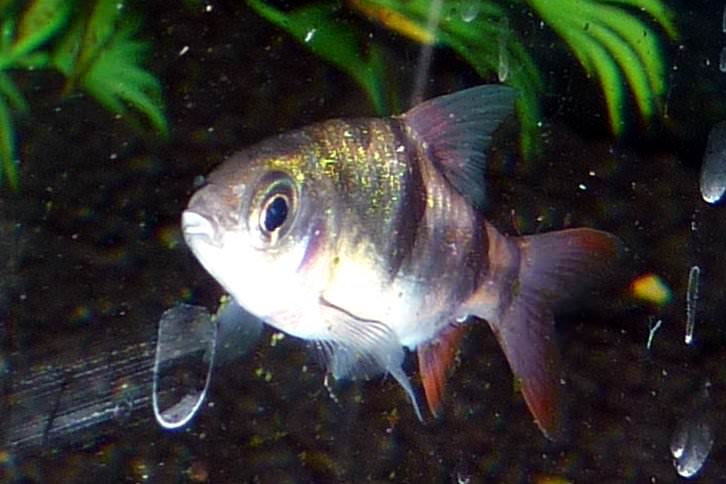
The Clown Barb is a very popular freshwater fish that is easily recognizable thanks to its unique coloration.
As the name suggests, these fish are mostly clown-like in appearance. They have a white body with black spots that are dotted along their sides.
The fins on a Clown Barb are mostly clear with a white base. The dorsal fin is short and starts about two-thirds of the way back on the body. The anal fin is slightly longer and begins just before the halfway point.
The caudal fin is forked and symmetrical. The pectoral fins are also clear and start just behind the gill plate.
Clown Barbs have a long and thin body shape that is very hydrodynamic. This helps them swim quickly and easily navigate their aquatic environment.
Lifespan
The clown barb is a long-lived fish, with a lifespan of up to 15 years in captivity.
As with all fish, the lifespan of clown barbs can be impacted by a number of factors, including water quality, diet, and stress levels.
That said, these fish are relatively hardy and do well in a wide range of conditions. As long as you provide them with a good quality of life, they should thrive for many years.
Size
Clown barbs can grow to be up to 3 inches in length, but they are typically around 2 inches. These are small fish that don’t need a lot of space to swim and explore.
Tank
Tank Size
The minimum tank size for a clown barb is 20 gallons. If you’re planning on keeping a school of these fish, you’ll need at least 30 gallons for every 5 fish.
Clown barbs are peaceful fish but they are also very active. They love to swim and explore so you need to make sure they have enough room to do so.
A 20 gallon tank is the minimum we would recommend but if you have the space, a 30 or 40 gallon tank would be ideal.
Water Parameters
The clown barb is a tropical fish that requires warm water and a bit of a current to stay healthy.
While they are a bit more demanding than some of the other freshwater fish on this list, they are still a good choice for a beginner.
Just be sure to do your research and be prepared to provide the correct water conditions.
Here are a few basic water parameters to help create a healthy clown barb environment.
- Water temperature: 75 to 82 degrees Fahrenheit
- pH levels: 6.5 to 7.5
- Water hardness: 4 to 10 dGH
- Alkalinity Levels: 4-8 dKH
What To Put In Their Tank
Clown barbs are a schooling fish, which means they do best when kept in groups. We recommend a group of at least 6, but more is always better.
When it comes to setting up their tank there are a few things you’re going to want to include.
First, you need to have a lot of plants. Clown barbs love to hide amongst the foliage, so the more plants you have the better.
We recommend going with live plants if you can, but fake plants will work in a pinch too. Just make sure they’re not too big or the fish might have a difficult time swimming through them.
Second, you’re going to want to include some driftwood or rocks. These provide a great hiding spot for these fish and can help make the tank feel more natural.
Again, avoid anything too big since these fish aren’t the best swimmers.
And lastly, you’re going to want a substrate that’s on the softer side. These fish like to dig, so a substrate that’s too hard can damage their barbels.
Common Diseases
Clown barbs are a hardy and relatively disease-resistant fish. However, they can still fall ill if the water quality in their tank is poor.
The most common disease that these fish experience is ich. This is a parasites that affects freshwater fish and can be quite serious if left untreated.
The most obvious symptom of ich is the presence of white spots on the body of your fish. These spots will eventually turn into sores, and if left untreated can lead to death.
There are plenty of other potential diseases that can affect clown barbs, but they’re not as common.
Another thing to look out for is infection from cuts. The most common cause of this is keeping your clown barb in a tank with a rough substrate (or aggressive species that want to fight).
In general, the best way to prevent these fish from getting sick is to maintain the quality of the water in their tank. A tank with clean and stable water conditions always leads to healthier fish who are more resistant to disease.
Behavior & Temperament
Clown barbs are one of the more peaceful species of barbs. They’re not as active as some of the others, but they’re still fun to watch. These fish prefer to stay in schools and are very social creatures.
Clown barbs are active swimmers and love to explore their surroundings. They’re not afraid to venture to the top of the tank, but they prefer to stay near the middle or bottom. That’s where most of the action is, after all.
These fish are also known for being good jumpers. So, if you don’t have a lid on your tank, be prepared for your clown barbs to make a break for it!
When it comes to temperament, clown barbs are relatively peaceful. They may nip at the fins of other fish, but they typically don’t cause any serious harm.
Tank Mates
The clown barb is a schooling fish. This means that they do best when kept in groups of 6 or more.
Clown barbs are peaceful fish and get along well with other species. They’re not known to be fin nippers or bullies.
Because they’re not aggressive, you have a lot of flexibility when it comes to choosing clown barb tank mates.
In general, you want to avoid keeping them with larger, more aggressive fish. They’re not the biggest fish in the world, and they can easily get outcompeted for food.
Here are some good clown barb tank mates:
- Cherry barb
- Tetras
- Guppies
- Platies
- Mollies
- Swordtails
Breeding
The clown barb is a beautiful fish that’s not too difficult to breed in captivity. They’re native to Southeast Asia and can be found in slow-moving rivers and streams.
Clown barbs typically reach maturity around 6 months of age. At that point, you can begin the breeding process.
Start by setting up a breeding tank. It should be at least 30 gallons and well-filtered. The water should be soft with a pH between 6.5 and 7.0.
Then, add some live plants and a few hiding places. Driftwood is a good option. Clown barbs like to lay their eggs on plants, so the more you have, the better.
When ready, add two females for every male. Males are usually a bit larger and have longer fins.
Feed the fish plenty of live foods. Then, begin changing about 50 percent of the water. That should trigger spawning.
You’ll know you’re successful when you see the female lay her eggs on the plants. After she does that, the male will guard them diligently.
The eggs will hatch in about 5 days. At that point, you can remove the adults and begin feeding the fry baby brine shrimp.
Conclusion
Clown barbs are a great addition to any freshwater aquarium. They’re relatively easy to care for, and their lively personality will be a hit with everyone in the family.
Clown barbs are also a great choice for beginner fishkeepers. They’re hardy and can tolerate a wide range of water conditions, so you don’t have to be as vigilant as you would with other fish.
We think they’re a great choice for anyone looking to add some personality to their tank!

